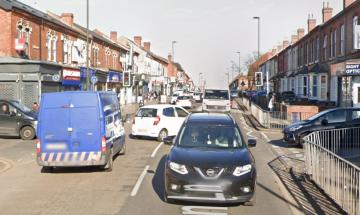
Birmingham City Council (BCC) is consulting on initial proposals for improving walking and cycling conditions in Bordesley, focusing on 5 corridors. From the information in the consultation, called ‘Connecting Bordesley Green’, it seems that this is the first of two consultation stages, so the proposals so far are fairly broad-brush, but feedback now will have a big impact on what direction forward is taken. The consultation will close on Friday 1st March 2024.
Here is the link to the consultation: Connecting Bordesley Green.
Our overall view:
We support the ‘do maximum’ solutions where they propose delivering segregated cycle infrastructure that links together coherently with good junction design and serves destinations such as hospitals and schools, in corridors D, E and half of A. We think that these would add some useful links to the wider Birmingham cycle network.
But we disappointed that the best practices seen in other parts of Birmingham for delivering places for people to live and play have not been applied here. Much of this area is made up of terraced housing, where there is a high demand for car parking space, but also a high flow of rat-running motor traffic. A lot can be done to improve streets for local residents by putting in a few strategic bollards which would also improve conditions for cycle users. This is an approach supported by the most recent government guidance. LTN 1/20, section 3.5, discusses the importance of an area based approach, suggesting that creating areas with low volumes of motor traffic, and then linking those up, can be a good method to build up wider areas that are friendly to cycling.
Creating areas that are friendly to cycling is important, because corridors with high quality cycle infrastructure are not sufficient on their own - if the residential road you live on is full of rat-running motor traffic, you are not going to feel comfortable enough on your own street to be able to cycle to the high quality cycle track on the next street. There are, broadly speaking, two things that BCC need to be focusing on to improve conditions for cycling:
(1) Delivering a network of high quality cycle routes to help people to cycle across Birmingham.
(2) Removing rat-running motor traffic from residential areas, to make the residential streets comfortable for people to walk and cycle on.
The current consultation focuses on that first task, but avoids the challenge of the second task. But this will mean that local residents may still face intimidating rat-running motor traffic on their own street, discouraging them from cycling to reach the higher quality cycle network. We believe that without tackling that second task as well, a safe and welcoming walking and cycling environment will not be created in this area.
What is proposed in the consultation?:
The consultation covers Bordesley Green, from the train line to the north of the area, to the A45 on the south. There are 5 routes through the area identified as apparently key for taking action to improve conditions for active travel. The best thing to do is have a look at the map on the consultation page (where they are called ‘corridors’) alongside reading these evaluations of the 5 routes.
Corridor A:
This runs from the Small Heath Bridge over the A45, across to Yardley Green Road alongside Birmingham Heartlands Hospital. This route crosses the other 4 routes, and runs the length of the area. The 'do maximum' proposals east of Blechers Lane have segregated cycle tracks and new junction designs to maintain continuity. Unfortunately the rest of the measures proposed for the route will not do much for cycling conditions. Where one-way streets with contra-flow cycle tracks are proposed, it is not clear what will be done to improve cycling conditions for people cycling with the flow of motor traffic, as there do not appear to be any proposals to reduce motor traffic levels. Preventing rat-running motor traffic from crossing Small Heath Bridge would make a big difference to the levels of motor traffic in this area, for example.
Corridor B:
This runs north to south, from Adderley Park Station down to Golden Hillock Road and the Poets Corner roundabout. The 'do maximum' proposals have nothing that would make a family with their 8 year old child on their own bike feel comfortable cycling along here. Signalised cycle priority junctions do not help anyone who is not already confident cycling on roads full of motor traffic, and are far too expensive for the minimal benefit that they would provide. We would oppose wasting money on the measures proposed for cycle users on Corridor B.
Corridor C:
This is parallel to B, starting just the over side of South and City College, from Pretoria Road down to Tennyson Road, to meet the cycle track that runs parallel to the A45 from the Middle Way to Tennyson Road. The 'do maximum' proposals include some signed 'quiet routes' parallel to the corridor, as well as contra-flow cycle tracks along streets that will be made one-way for motor traffic. It is unclear if both options would be implemented and whether the introduction of one-way streets for motor traffic would increase the motor traffic on the 'quiet routes'. We do not think that one-way streets for motor traffic should be introduced without a wider vision for how motor traffic should flow through (or not) an area.
Corridors D and E:
These run either side of Heartlands Hospital, D down Belchers Lane and then Monica Road, while E runs parallel to the River Cole, down Little Bromwich Road, along to Coventry Road at the Heybarnes Circus.
Corridor D has a segregated cycle track proposed for Belchers Lane, past Heartlands Hospital, but one-way streets with contra-flow cycle track along Monica Road. If there are no measures to reduce the volume of motor traffic, then we do not think that this is suitable for people cycling with the flow of cars along Monica Road. Other measures will be needed to make this suitable for cycling on with small children.
For corridor E, segregated cycle tracks are proposed for the whole length, with a couple of different junction designs proposed, including a Cyclops junction, which is being used as the standard design in Manchester. It is important to note, though, that Manchester is generally building one-way segregated cycle tracks either side of the road, but Birmingham more commonly builds a single bi-directional cycle track on just one side. Cyclops junctions work best with one-way cycle tracks either side, so it might not be the best design for Birmingham's bi-directional cycle tracks.


